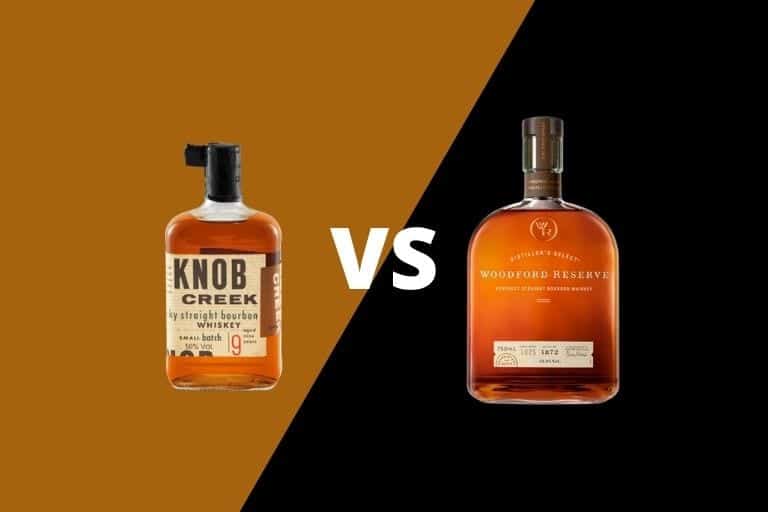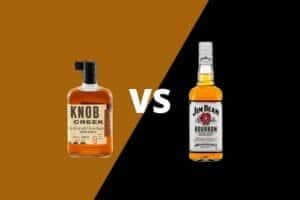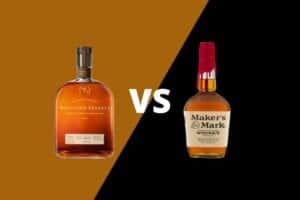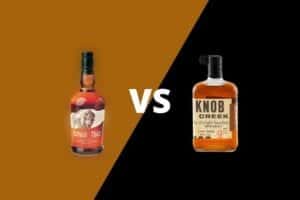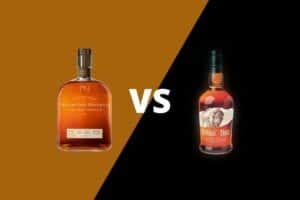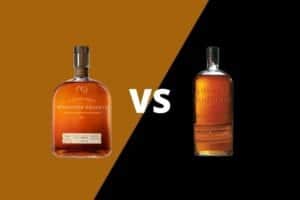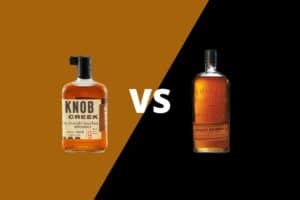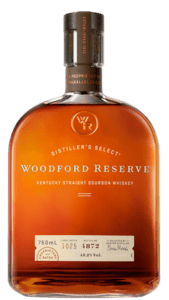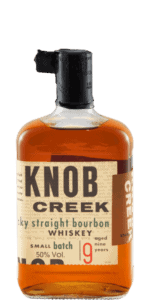We’ve got ourselves a very fine matchup, indeed.
Most bourbon drinkers are familiar with the names Knob Creek and Woodford Reserve. But a closer look shows how a glass of bourbon can teach us about the process of making whiskey.
In this matchup, we will examine not only these two brands, but how the influences of charred American oak barrels, mash bill recipes and copper pot stills impact the taste of the liquid in your glass.
Table of Contents
History
This matchup is between two 1990s babies.
After a couple of decades of depressed sales in the 1970s and 80s, things finally started to turn around for the Bourbon whiskey category. A new generation of drinkers was coming of age. And where the Baby Boomer generation rejected bourbon as the old man’s drink of their fathers, Generation X showed a willingness to embrace bourbon’s traditional oak and corn flavor profile.
As interest in the category grew, whiskey makers attempted to take advantage of newfound enthusiasm.
At Jim Beam, legendary Master Distiller Booker Noe cooked up a plan to create a more mature and higher-proof bottling to honor the past and help elevate the category. Knob Creek was the result of that endeavor. Booker Noe is credited with coining the term ‘small batch’ to help describe the craftsman’s approach to creating this unique bourbon style.
It was a fitting descriptor.
Compared to the approach for high-volume bourbons like keystone brand Jim Beam white label — the No. 1 selling bourbon brand in the world — the small batch approach to Knob Creek was quite different. By carefully choosing which barrels to dump for each batch, the production team could develop entirely new flavors. Its success went a long way in convincing customers — and the bourbon industry in Kentucky — that well made bourbon products could be worthy of higher prices.
We’ll take a closer look at the way small-batch bourbons are created in the Maturation section.
Knob Creek was released as part of the Jim Beam Small Batch Bourbon Collection — along with Booker’s, Baker’s and Basil Hayden’s bourbon brands. Although the bourbon enthusiast community has warmly embraced each offering, Knob Creek arguably has had the most significant impact on the market.
Knob Creek was released in 1992. The following year, moves were being made in Kentucky that would eventually lead to the launch of the Woodford Reserve brand.
In 1993, Brown-Forman purchased the historic Oscar Pepper Distillery near Versailles, Kentucky. They invested in rehabilitating a deteriorated facility — including the refurbishment of the three 1,500 gallon copper pot stills on site. The plan was to create a bourbon brand unlike anything on the market at the time.
When the site was brought back online, it was christened as the Woodford Reserve Distillery. In 1996, the first bottles of Woodford Reserve Bourbon were released in the United States.
Ownership
Knob Creek is produced by Beam Suntory, makers of the No. 1 selling bourbon in the world — Jim Beam Kentucky Straight Bourbon Whiskey.
Woodford Reserve is produced by Brown-Forman, makers of the No. 1 selling American whiskey in the world – Jack Daniel’s Tennessee Whiskey.
Woodford Reserve and Knob Creek allow the two powerhouse spirits producers Brown-Forman and Beam Suntory, respectively, to go head-to-head in the competitive premium bourbon pricing segment.
Mashbills
The mash bill is the list of grain ingredients used to produce each product. By looking at the grain bill, we can learn more about some of the flavors in the final product.
Knob Creek contains 75 percent corn, 13 percent rye and 12 percent malted barley.
Woodford Reserve contains 72 percent corn, 18 percent rye and 10 percent malted barley.
While both products could be considered a traditional bourbon recipe, an additional percentage of corn will often lead to sweet corn notes, while rye is associated with spice or black pepper notes and malted barley with nuttiness.
But for both brands, the grain plays second fiddle to other attributes. The main story in this matchup is between Knob Creek’s 9-year age statement and Woodford Reserve’s use of traditional copper pot stills.
Maturation
The maturation process describes how the clear ‘white dog’ or ‘newmake’ spirit transforms over the course of years through the barrel aging process into a refined bourbon.
To be labeled as bourbon, the liquid inside the bottle must have been matured in new American charred oak barrels. This requirement is unique to American whiskey and gives products created in the United States the big, bold flavor profile internationally recognized by whiskey fans. Charring the inside of the barrel caramelizes the sugars in the wood, and the char layer acts as a natural carbon filter, eliminating undesired flavor components in the distillate.
The maturation process is something you can taste in the finished whiskey. Maturation gives whiskey the flavor notes of vanilla and baking spice and helps to round and mellow the finished product.
The term small batch was created by Booker Noe to describe the more artisan approach to bourbon making — one that used more extended periods of aging in wood barrels, was more selective in the choice of barrels, utilized sweet spots in the warehouse and pulled smaller batch sizes to create a product with an entirely different flavor profile.
Jim Beam owns numerous rackhouses — the large wooden maturation warehouses most often associated with Kentucky bourbon production, also known as rickhouses. At any given time, tens of thousands of barrels of spirit can be slumbering in these traditional wooden structures. Most of these barrels will be dumped to meet the demand for Jim Beam core products like their white label bourbon whiskey.
But in each warehouse, members of the production team have found sweet spots over the years. Each warehouse has a unique micro-environment, with heat and humidity fluctuations playing a considerable role in how the spirit resting in barrels mature inside. And in a traditional non-climate controlled rack house, there are spots throughout the multi-storied buildings that have been recognized for having that special touch — creating barrels with extraordinary flavor and quality.
By pulling a combination of these special barrels, the master blender can develop a product with an entirely different flavor profile — even when all of the barrels within the rickhouses start out as nearly identical barrels filled with the same distillate.
Distillation & Production
Beam Suntory operates several production facilities in Kentucky, including the Booker Noe plant in Boston, Kentucky, and the Jim Beam Distillery in Clermont. Knob Creek is produced at the Clermont facility. Beam Suntory also operates the Maker’s Mark Distillery in Loretto.
Brown-Forman operates two Kentucky facilities — the Brown-Forman Distillery in Shivley, Kentucky, and the Woodford Reserve Distillery in Versailles. Pot distillations are run through the three large copper-pot stills at the Woodford Reserve Distillery, while spirit distilled using column reflux is produced at the Brown-Forman plant. The most widely distributed expression of Woodford Reserve — Woodford Reserve Distiller’s Select Bourbon — contains barrels of bourbons produced at both plants in each batch.
Brown-Forman also operates the Jack Daniel’s Distillery in Lynchburg, Tennessee — by far the largest distillation plant in the United States.
Price Point & Value
Knob Creek will cost you about $35 for a 750mL bottle at 100-proof, or 50 percent alcohol by volume.
Woodford Reserve will cost you about $39 for a 750mL bottle at 90.4 proof, or 45.2 percent ABV.
Both bourbons are considered to be in the premium pricing segment. The product attributes — copper pot distillation for Woodford Reserve and the 9-year age statement for Knob Creek — make each a great deal in their price range.
Tasting Notes
Knob Creek Bourbon
Appearance: In the glass, Knob Creek appears almost thick enough the chew and, at 100-proof, has beautiful thick legs. Its light brown color hints of auburn and polished mahogany.
Nose: The aroma of rich toffee, with fragrant notes of vanilla, buttery caramel, raisins and honey.
Palate: Heavy barrel oak flavors of baking spices, vanilla and cinnamon, with tobacco and black pepper notes.
Finish: Lingering notes of chocolate, nougat, vanilla, almonds, leather and a pleasant campfire smokiness.
[Related: Complete Knob Creek Bourbon Review]
Woodford Reserve Distiller’s Select Bourbon
Appearance: In the glass, Woodford Reserve has the deep gold color of burnished copper. It has healthy legs at 90.4-proof.
Nose: New oak aromas of caramel and vanilla, with notes of almonds, toffee and dark chocolate.
Palate: Corn sweetness and a buttery mouthfeel, with flavors of almonds, walnuts, chocolate, cinnamon, vanilla and raisins.
Finish: Chocolate, vanilla, with lingering notes of leather and tobacco and a hint of smoke.
[Related: Complete Woodford Reserve Review]
Verdict…
If you have been lucky enough to try both brands, you’d know you could do worse than to place these two side-by-side in a blind tasting. If you haven’t, there’s no time like the present.
For the bourbon fan looking to expand their understanding of the category, it’s the perfect trade-up opportunity. Their place in the premium pricing segment puts them in the Goldilocks zone of bourbon — the perfect bourbon for happy hour at your favorite whiskey bar, affordable enough to keep on your bar as an everyday bourbon and an extremely nice bourbon to use for a high-end craft cocktail. And by knowing a little more about the products, we can connect the dots in our brains between that extra corn and the sweet caramel notes, the barrel maturation and the tobacco and leather notes and the rye grain with that bit of spice.

